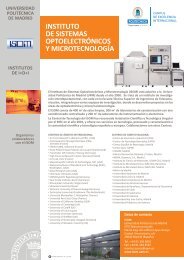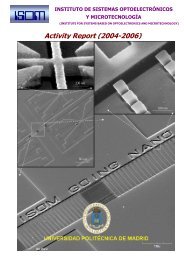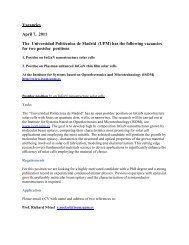Graphene-on-SiC - ISOM
Graphene-on-SiC - ISOM
Graphene-on-SiC - ISOM
Create successful ePaper yourself
Turn your PDF publications into a flip-book with our unique Google optimized e-Paper software.
TECHNOLOGY GaN POWER ELECTRONICS<br />
Boosting GaN-<strong>on</strong>-silic<strong>on</strong><br />
blocking voltages<br />
A misc<strong>on</strong>cepti<strong>on</strong> is holding back the development and deployment of<br />
GaN devices that are built <strong>on</strong> silic<strong>on</strong> substrates. This platform is widely<br />
blamed for compromising blocking voltages, but it doesn’t: It is possible to<br />
make diodes and HEMTs <strong>on</strong> silic<strong>on</strong> that have breakdown voltages of well<br />
over 2 kV, according to Timothy Boles and Douglas Carls<strong>on</strong> from M/A-COM<br />
Technology Soluti<strong>on</strong>s, Tomas Palacios from MIT and Mike Soboroff, who<br />
recently moved from the US Department of Energy to Rock Creek Strategies.<br />
GaN HEMTs arE oN THE vErGE of<br />
revoluti<strong>on</strong>izing the power electr<strong>on</strong>ics industry,<br />
thanks to their capability to take device<br />
performance to a new level. Their tremendous<br />
promise has already spurred widespread<br />
academic and industrial development of<br />
transistors for power switching applicati<strong>on</strong>s<br />
that have an impressive set of attributes: power<br />
densities of more than 2 W/mm; c<strong>on</strong>tinuous<br />
current handling capabilities of 10 a or more; and<br />
very high reverse breakdown blocking voltages,<br />
which typically exceed 1 kv. Prototypes of these<br />
transistors have been built <strong>on</strong> sapphire, <strong>SiC</strong> and<br />
silic<strong>on</strong> − three platforms with differing pros and<br />
c<strong>on</strong>s.<br />
Efforts at device development have delivered<br />
much heralded, well-deserved technical<br />
successes, but this is yet to lead to significant<br />
commercial adopti<strong>on</strong> of GaN. There are many<br />
explanati<strong>on</strong>s for this, and they tend to revolve<br />
around the view that while GaN diodes and<br />
transistors produce impressive results, they are<br />
far more expensive than their silic<strong>on</strong> rivals. or, to<br />
put it in simper terms, they d<strong>on</strong>’t get close to the<br />
bang-per-buck of the incumbent technology.<br />
This explains what is happening in the<br />
marketplace today. In this arena, the limited<br />
success of GaN products can be accounted for<br />
by citing a widely held mantra: <strong>on</strong>ce the minimum<br />
level of performance needed for the applicati<strong>on</strong><br />
is achieved, the cheapest soluti<strong>on</strong> will win. So, in<br />
order for GaN-based products to realize their full<br />
potential in a broader marketplace, two changes<br />
must take place: The cost of material must<br />
plummet; and device manufacturers must target<br />
applicati<strong>on</strong>s that cannot be addressed by lowercost<br />
rival technologies, such as those based <strong>on</strong><br />
silic<strong>on</strong>.<br />
Figure 1. A typical GaN<br />
HEMT epitaxial structure<br />
<strong>on</strong>e route to driving down the cost of GaN devices<br />
involves building them <strong>on</strong> silic<strong>on</strong> and processing<br />
them in silic<strong>on</strong> lines. Staff at the US Department<br />
of Energy (DoE) subscribe to that view, and<br />
they are funding a project to investigate and<br />
ultimately commercialize GaN-<strong>on</strong>-silic<strong>on</strong> power<br />
device technology. We are all involved, and we<br />
42 www.compoundsemic<strong>on</strong>ductor.net April/May 2013











